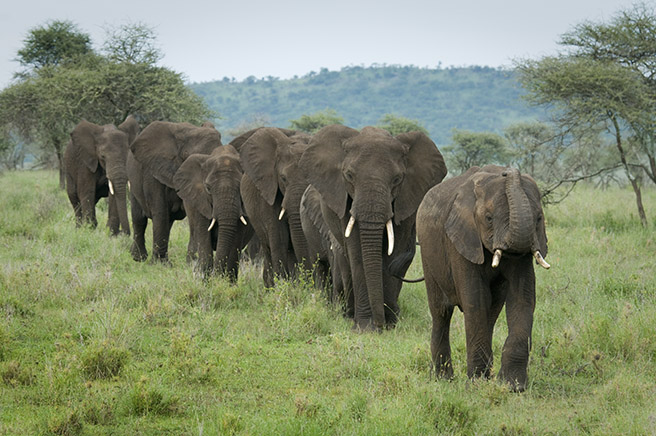Counting All Elephants

How a census aids in elephant conservation work
Count sheep. That’s the advice given to people having trouble falling asleep—a clear indication that most don’t consider counting animals an exciting task. Yet the counting of animals is crucial to conservation efforts. Wildlife censuses help gauge population patterns and distributions across habitats and time.
This is especially critical for Africa’s elephants, given the extent of the illegal wildlife trafficking crisis. According to a recent study, which involved data collected by numerous conservation organizations, including AWF, 65 percent of all forest elephants had been killed for their ivory over the past decade.
A 2014 elephant census conducted in Selous Game Reserve in southern Tanzania, which boasts among the largest elephant populations in East Africa, found that the reserve’s population had fallen an astounding 67 percent since 2010. The census, coordinated by two AWF partners and conducted at the behest of the Tanzanian government, estimated that only 13,683 elephants remain in the ecosystem—compared to 110,000 only 30 years ago.
“There was a time when the Selous ecosystem looked safe from poaching, because of the sheer number of elephants in that expansive landscape. But in conservation, you can never be safe,” observed Philip Muruthi, AWF’s senior director of conservation science.
And that’s the purpose of such counts, to affirm the stability—or not—of wildlife populations. In response to the current African elephant-poaching crisis, AWF identified 10 critical populations across sub-Saharan Africa, comprising nearly two thirds of the continent’s total elephant population. Populations were prioritized in part on size, threat severity, and feasibility of intervention. Under this strategy, AWF last year began channeling discrete amounts of funding via our Species Protection Grants program to support counter poaching efforts in some of these priority sites. Existing elephant conservation work also continues in AWF’s landscapes.
Turning the tide
In addition to illustrating where interventions are needed, censuses can be used to confirm whether certain strategies are working. In the Amboseli–West Kilimanjaro area between southern Kenya and northern Tanzania, AWF initiated a collaborative large-mammal count between Kenya Wildlife Service and Tanzania Wildlife Research Institute in the 2000s to enhance common conservation practices in this cross-border area. The partners now conduct an integrated aerial and ground census of large herbivores every three years.
The 2013 census found that the savanna elephant population increased slightly from 2010, from 1,420 individuals to 1,930—confirming that the population had steadily recovered from the severe drought of the late 2000s. Meanwhile, the number of observable elephant carcasses had declined 40 percent.
According to the report, the resilience of the population “is largely attributable to the transboundary nature of their distribution … and successful anti-poaching operations and cross-border meetings conducted between community scouts and wildlife authorities from both countries, with support from AWF.”
It’s this kind of data that lends credence to how we work and defines where we need to focus our efforts. For AWF, counting animals will continue to provide the backbone for our conservation work.
Learn about a mountain gorilla census that brought joy to the conservation community!
Photo: Barbara von Hoffmann / vonhoffmannphotography.com